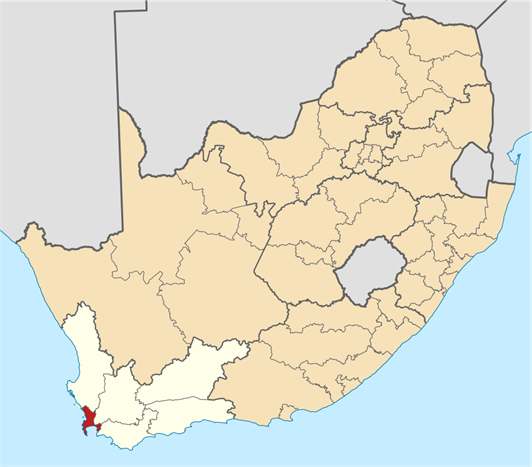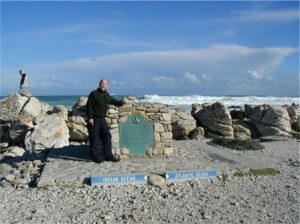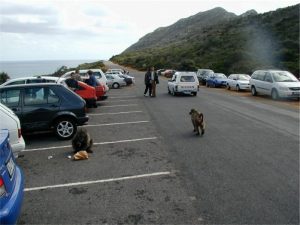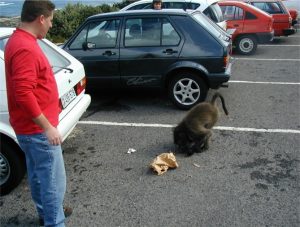70 Baboons of Capetown
Rick Bein
The Baboons of Cape Town
Baboons around Cape Town, South Africa (at the southern tip of Africa) are semi protected. They are left in some of the upland areas away from the majority of people to fend for themselves. Most of these bands occupied secluded areas of Table Mountain and in the interior
 Map of South Africa with Cape Town highlighted (2011).svg by Htonl licensed under CC BY-SA 4.0 From Wikimedia Commons, the free media
Map of South Africa with Cape Town highlighted (2011).svg by Htonl licensed under CC BY-SA 4.0 From Wikimedia Commons, the free media

Rick Bein at Cape Arugulas where two oceans meet. Photo by Jonathan, 2006.
They enjoy some of their native diet, but have become accustomed to eating what they can obtain from humans. Often the food is given but most of the time it is stolen. The baboons travel in packs, sleeping bunched together in the bush. They spend the day roving around seeking food. Garbage dumps are likely sites, and small animals like dogs and cats are targeted.
Open doors are favorites. A band of baboons can ransack a house in a matter of minutes, ripping down curtains, knocking over refrigerators and making off with large quantities of food. They usually leave deposits of excrement, some of which they smear on the walls and furniture.
The small, secluded, all-white town of Scarborough sits south of Cape town and Table Mountain along the Atlantic Coast about 5 miles north of Cape point. It is vulnerable to the ravages of the baboons which periodically raid the village. Doors are kept locked and people keep an eye out for each other with respect to the invaders.
The town of Scarborough hires a full time baboon watcher to shadow the local baboon clan and chase them away from homes and warn the people if the baboons still come into town. Even though this Xhosa man is physically fit to keep up with the baboons, he also has an old bicycle that he keeps close to where the baboons spend the night. Should the baboons trick him and get a head start into town, he is able to peddle on ahead to try and block their progress. Because they are protected by the government, he is not allowed to kill the baboons, but he can shoot them with a sling shot to discourage them from advancing any further. He keeps a pocket full of small stones as ammunition.
While I visited in Cape Town in 2003, I toured with my friend Jonathan, one of the locals, to Cape Point, a promontory that marks the south west point of Africa that has been made into a major tourist attraction. Magnificent cliffs tower over the roiling sea below. Thousands of birds nest in the crevices of the rocks not far from their source of fish that thrive in the up welling water. Typical tourist haunts with curios, souvenirs and snack food crowd the edges of the park.
After enjoying the sites, we retreated to the parking lot to get ready to return to Cape Town. Jonathan suddenly decided that it would be nice to have a snack for our return journey. He walked quickly back to one of the shops and bought some food.
He trotted gently back toward us, carrying a paper bag in his right hand. That was the moment for one of the local baboons who had been hiding in the bushes beside the parking lot. Running up from behind Jonathan, the baboon tried to snatch the bag from his hand. At the last moment Jonathan pulled the bag out of the grasp of the groping baboon and fled in between two cars.

Within seconds the baboon followed, leaping onto one of the cars and immediately onto to my friend’s shoulders, straddling the back of his neck, holding on to his head with one hand and reaching for the food with the other.

It became apparent to Jonathan that this baboon was determined and was not going to give up without an even more serious fight. Besides, he did not like having the baboon’s nasty rear end resting on the back of his neck. Tossing the food onto the ground was all that was needed to free himself as the baboon jumped after the food and began tearing up the paper bag. Fortunately for Jonathan, the only wounds were his lost pride at having been tricked by the baboon.

